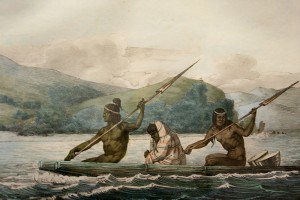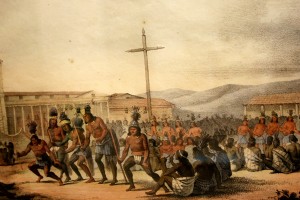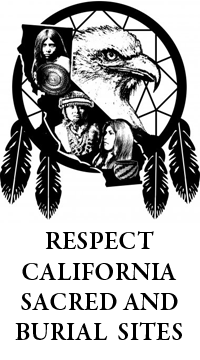Sogorea Te or Ssogoréate was a large village and
gathering/ceremonial ground utilized by dozens of tribes who lived near and around the San Francisco Bay Area, including the Carquin or Karkin [Ohlone], Huchiun-Aguasto [Ohlone], Suisun/Patwin [Southern Wintun], Bay Miwok, Coast Miwok, Yokuts, and Wappo. For over 3500 years, indigenous people gathered at Sogorea Te or Glen Cove, a large, shallow natural cove at the narrowest portion of the Carquinez Strait, ideal for making land crossings. The following excerpts, taken from Randall Milliken’s book, A Time of Little Choice: The Disintegration of Tribal Culture in the San Francisco Bay Area 1769-1810, convey brief glimpses of the original people of the land, through the eyes of the invaders.
Spanish invader Pedro Fages’ 1772 expedition
In March of 1772, Pedro Fages came up through the Santa Clara Valley into the East Bay. His party continued northward and eastward into the interior (see Map 3, page 33). Huchins on the southeast shore of San Pablo Bay received the alien visitors with great joy, as diarist Juan Crespi noted:
We found a good village of heathen, very fair and bearded, who did not know what to do, they were so happy to see us in their village. They gave us many cacomites, amoles, and two dead geese, dried and stuffed with grass…. We returned the gift with beads, for which they were very grateful, and some of them went with us to another village near by (Crespi [1772] 1927:291).
All along the Carquinez Strait Huchiun-Aguastos and Carquins harvesting the spring salmon run welcomed the Spaniards:
On the banks of the other [North] side we made out many villages, whose Indians called to us and invited us to go to their country, but we were prevented by a stretch of water about a quarter of a league wide; and many of them, seeing that we were going away, came to this side, crossing over on rafts, and gave us some of their wild food (Crespi [1772] 1927:293) [p. 37]
Juan Bautista de Anza and his party of Spanish invaders, 1776
…local men accompanied the Anza party to the Huchiun-Aguasto village:
After going a short distance we came to the village, which was in a little valley on the bank of a small arroyo, the Indians welcoming us with indescribable hullabaloo. Three of them came to the edge of the village with some long poles with feathers on the end, and some long and narrow strips of skin with the hair on, which looked to me like rabbit skin, hanging like a pennant, this being their sign of peace. They led us to the middle of the village where there was a level spot like a plaza, and then began to dance with other Indians of the place with much clatter and yelling.
A little afterward a rather old Indian woman came out, and in front of us, for we were on horseback, nobody having dismounted, she began to dance alone, making motions very indicative of pleasure, and at times stopping to talk to us, making signs with her hands as if bidding us welcome. After a short while I said to the commander that was enough. So he gave presents of glass beads to all the women, they regaled us with their cacomites, and we said goodbye to everybody, in order to continue on our way (Font [1776] 1930:368). [p. 65]
Upon leaving the Huchiun-Aguasto village on the morning of April 2, the Anza party proceeded eastward on a route overlooking the great fishing waters of Carquinez Strait. They saw some Carquin men sturgeon fishing with nets from their tule boats:
We called to these Indians, offering to buy their fish from them. At first they paid no attention to us, but as soon as the commander showed them a colored handkerchief they came to the shore in a hurry, bringing two very large fish….
The commander offered glass beads for them, but the Indians would not accept them at all, wishing to trade them only for clothing. Indeed, I did not see in any other place Indians like these, so desirous of clothing and so greedy for it that I was surprised, for they preferred any old rag to all the glass beads, which others are so fond of (Font [1776] 1930:372)
Missionization of the Carquins
“The Carquins and the Chupcans were the only East Bay groups that were still intact at the end of 1805. They and the remaining non-Christian Huchiun-Aguastos had certainly withdrawn to the north side of Carquinez Strait by the end of 1805.” [p. 191]
“The Carquin people finally moved to Mission San Francisco in June of 1809, after successfully resisting Spanish expansion for three or four years longer than might have been expected. Ten of the sixty Carquin children under the age of ten who were baptized that summer had parents who were deceased. None of the Carquins admitted to having been married to any of the Suisuns, which may merely reflect their desire to maintain some social distance from the Suisuns [Patwin], who were considered by both the old neophytes and the Spaniards to be criminals.” [p. 209]
Most of the people from the nearer East Bay villages were content to make no more than occasional visits to Mission San Francisco during the 1780s. Among those who did become neophytes were some young people who came from great distances, and who were married at the mission so quickly that we must assume their marriages had been previously arranged.
In 1788 Blandina Guaiámay came from “the village of Ssogoréate at the port of La Assunta near the mouth of the large river of Our Father San Francisco, of the Aguasajuchiun family” to marry Bonifacio from the East Bay village Chinau the next day. [p. 103]
The pain of missionization
Account from Mission San Francisco:
Twice in the year they receive permission to return to their native homes. This short time is the happiest period of their existence; and I myself have seen them going home in crowds, with loud rejoicings. The sick, who cannot undertake the journey, at least accompany their happy countrymen to the shore where they embark, and there sit for days together, mournfully gazing on the distant summits of the mountains which surround their homes; they often sit in this situation for several days, without taking any food, so much does the sight of their lost home affect these new Christians (Kotzebue [1816] 1932:63). [p. 219]
Description of the Carquin, Huchiun-Aguasto, and Suisun tribes
From the Appendix of Randall Milliken’s book, A Time of Little Choice
Carquin (Costanoan language) – A tribe on both sides of the Carquinez Strait in the present Port Costa, Martinez, Benicia area. Father Abella of Mission San Francisco passed through the “estrecho de los Carquines” during an exploration of the Central Valley in 1811 (Cook 1960:261). The “Estrecho de Karquines” also appears on Father Duran’s 1824 Plano Topografico (Bennyhoff 1977:166). Bennyhoff (1977:137-144) felt strongly that they held only the southern side of Carquinez Strait, while the Aguastos, whom he identified as Patwin speakers, held the north side of the Strait. The specific Aguasto group of that area, the Huchiun-Aguastos, may have held the north side of Carquinez Strait from Glenn Cove west to Mare Island, but they were clearly Costanoan speakers and heavily intermarried with the Carquins (see Huchiun-Aguasto in this appendix). I see no evidence for any other group to the north of Carquinez Strait until one reaches the Napa and Suisun tribes, tribes definitely not located on Carquinez Strait. A total of 152 Carquins went to Mission San Francisco, most of them in 1809 and 1810. [p. 138 – Appendix]
Huchiun-Aguasto (Costanoan language) – The Huchiun-Aguastos held lands in the East Bay on the southeast shores of San Pablo Bay. The first member of the group identified in San Francisco baptismal records was Blandina Guaiamay from “the village of Ssogoreate on the port of the Assumption near the outlet of the great river of Our Father San Francisco, of the family of the Aguasajuchiun” (SFR-B 708). Groups of Huchiun-Aguastos went to Mission San Francisco between 1803 and 1811, usually with Carquins or Huchiuns. Many of the 384 Mission San Francisco baptized merely as “Huchiuns” were probably Huchiun-Aguastos. Numerous nuclear families contain individuals from either named group.
Suisun (Patwin language) – The Suisuns lived on the north shore of Suisun Bay (Gudde 1969:324). Gabriel Moraga attacked their villages in May of 1810. His diary gives no details beyond the fact that the villages were north of Carquinez Strait. The route of Father Abella, who visited them in 1811, indicates a location in the present Fairfield area on the north side of Suisun Bay (Cook 1960:265). Suisuns were baptized at San Francisco between 1810 and 1816 (326 people). Francisco Solano, the Mexican-era associate of Mariano Guadalupe Vallejo, was a Suisun baptized at Mission San Francisco in July of 1810 at age 10 (SFR-B 4024).





